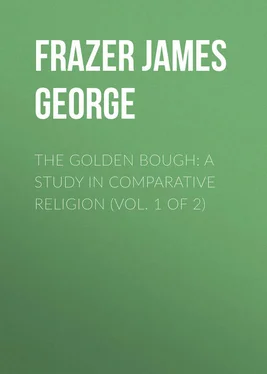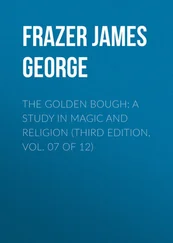James Frazer - The Golden Bough - A Study in Comparative Religion (Vol. 1 of 2)
Здесь есть возможность читать онлайн «James Frazer - The Golden Bough - A Study in Comparative Religion (Vol. 1 of 2)» — ознакомительный отрывок электронной книги совершенно бесплатно, а после прочтения отрывка купить полную версию. В некоторых случаях можно слушать аудио, скачать через торрент в формате fb2 и присутствует краткое содержание. Жанр: foreign_religion, foreign_antique, foreign_prose, на английском языке. Описание произведения, (предисловие) а так же отзывы посетителей доступны на портале библиотеки ЛибКат.
- Название:The Golden Bough: A Study in Comparative Religion (Vol. 1 of 2)
- Автор:
- Жанр:
- Год:неизвестен
- ISBN:нет данных
- Рейтинг книги:4 / 5. Голосов: 1
-
Избранное:Добавить в избранное
- Отзывы:
-
Ваша оценка:
- 80
- 1
- 2
- 3
- 4
- 5
The Golden Bough: A Study in Comparative Religion (Vol. 1 of 2): краткое содержание, описание и аннотация
Предлагаем к чтению аннотацию, описание, краткое содержание или предисловие (зависит от того, что написал сам автор книги «The Golden Bough: A Study in Comparative Religion (Vol. 1 of 2)»). Если вы не нашли необходимую информацию о книге — напишите в комментариях, мы постараемся отыскать её.
The Golden Bough: A Study in Comparative Religion (Vol. 1 of 2) — читать онлайн ознакомительный отрывок
Ниже представлен текст книги, разбитый по страницам. Система сохранения места последней прочитанной страницы, позволяет с удобством читать онлайн бесплатно книгу «The Golden Bough: A Study in Comparative Religion (Vol. 1 of 2)», без необходимости каждый раз заново искать на чём Вы остановились. Поставьте закладку, и сможете в любой момент перейти на страницу, на которой закончили чтение.
Интервал:
Закладка:
James George Frazer
The Golden Bough: A Study in Comparative Religion (Vol. 1 of 2)
Preface
For some time I have been preparing a general work on primitive superstition and religion. Among the problems which had attracted my attention was the hitherto unexplained rule of the Arician priesthood; and last spring it happened that in the course of my reading I came across some facts which, combined with others I had noted before, suggested an explanation of the rule in question. As the explanation, if correct, promised to throw light on some obscure features of primitive religion, I resolved to develop it fully, and, detaching it from my general work, to issue it as a separate study. This book is the result.
Now that the theory, which necessarily presented itself to me at first in outline, has been worked out in detail, I cannot but feel that in some places I may have pushed it too far. If this should prove to have been the case, I will readily acknowledge and retract my error as soon as it is brought home to me. Meantime my essay may serve its purpose as a first attempt to solve a difficult problem, and to bring a variety of scattered facts into some sort of order and system.
A justification is perhaps needed of the length at which I have dwelt upon the popular festivals observed by European peasants in spring, at midsummer, and at harvest. It can hardly be too often repeated, since it is not yet generally recognised, that in spite of their fragmentary character the popular superstitions and customs of the peasantry are by far the fullest and most trustworthy evidence we possess as to the primitive religion of the Aryans. Indeed the primitive Aryan, in all that regards his mental fibre and texture, is not extinct. He is amongst us to this day. The great intellectual and moral forces which have revolutionised the educated world have scarcely affected the peasant. In his inmost beliefs he is what his forefathers were in the days when forest trees still grew and squirrels played on the ground where Rome and London now stand.
Hence every inquiry into the primitive religion of the Aryans should either start from the superstitious beliefs and observances of the peasantry, or should at least be constantly checked and controlled by reference to them. Compared with the evidence afforded by living tradition, the testimony of ancient books on the subject of early religion is worth very little. For literature accelerates the advance of thought at a rate which leaves the slow progress of opinion by word of mouth at an immeasurable distance behind. Two or three generations of literature may do more to change thought than two or three thousand years of traditional life. But the mass of the people who do not read books remain unaffected by the mental revolution wrought by literature; and so it has come about that in Europe at the present day the superstitious beliefs and practices which have been handed down by word of mouth are generally of a far more archaic type than the religion depicted in the most ancient literature of the Aryan race.
It is on these grounds that, in discussing the meaning and origin of an ancient Italian priesthood, I have devoted so much attention to the popular customs and superstitions of modern Europe. In this part of my subject I have made great use of the works of the late W. Mannhardt, without which, indeed, my book could scarcely have been written. Fully recognising the truth of the principles which I have imperfectly stated, Mannhardt set himself systematically to collect, compare, and explain the living superstitions of the peasantry. Of this wide field the special department which he marked out for himself was the religion of the woodman and the farmer, in other words, the superstitious beliefs and rites connected with trees and cultivated plants. By oral inquiry, and by printed questions scattered broadcast over Europe, as well as by ransacking the literature of folk-lore, he collected a mass of evidence, part of which he published in a series of admirable works. But his health, always feeble, broke down before he could complete the comprehensive and really vast scheme which he had planned, and at his too early death much of his precious materials remained unpublished. His manuscripts are now deposited in the University Library at Berlin, and in the interest of the study to which he devoted his life it is greatly to be desired that they should be examined, and that such portions of them as he has not utilised in his books should be given to the world.
Of his published works the most important are, first, two tracts, Roggenwolf und Roggenhund , Danzig 1865 (second edition, Danzig, 1866), and Die Korndämonen , Berlin, 1868. These little works were put forward by him tentatively, in the hope of exciting interest in his inquiries and thereby securing the help of others in pursuing them. But, except from a few learned societies, they met with very little attention. Undeterred by the cold reception accorded to his efforts he worked steadily on, and in 1875 published his chief work, Der Baumkultus der Germanen und ihrer Nachbarstämme . This was followed in 1877 by Antike Wald- und Feldkulte . His Mythologische Forschungen , a posthumous work, appeared in 1884. 1 1 For the sake of brevity I have sometimes, in the notes, referred to Mannhardt's works respectively as Roggenwolf (the references are to the pages of the first edition), Korndämonen , B. K. , A. W. F. , and M. F.
Much as I owe to Mannhardt, I owe still more to my friend Professor W. Robertson Smith. My interest in the early history of society was first excited by the works of Dr. E. B. Tylor, which opened up a mental vista undreamed of by me before. But it is a long step from a lively interest in a subject to a systematic study of it; and that I took this step is due to the influence of my friend W. Robertson Smith. The debt which I owe to the vast stores of his knowledge, the abundance and fertility of his ideas, and his unwearied kindness, can scarcely be overestimated. Those who know his writings may form some, though a very inadequate, conception of the extent to which I have been influenced by him. The views of sacrifice set forth in his article “Sacrifice” in the Encyclopaedia Britannica , and further developed in his recent work, The Religion of the Semites , mark a new departure in the historical study of religion, and ample traces of them will be found in this book. Indeed the central idea of my essay – the conception of the slain god – is derived directly, I believe, from my friend. But it is due to him to add that he is in no way responsible for the general explanation which I have offered of the custom of slaying the god. He has read the greater part of the proofs in circumstances which enhanced the kindness, and has made many valuable suggestions which I have usually adopted; but except where he is cited by name, or where the views expressed coincide with those of his published works, he is not to be regarded as necessarily assenting to any of the theories propounded in this book.
The works of Professor G. A. Wilken of Leyden have been of great service in directing me to the best original authorities on the Dutch East Indies, a very important field to the ethnologist. To the courtesy of the Rev. Walter Gregor, M.A., of Pitsligo, I am indebted for some interesting communications which will be found acknowledged in their proper places. Mr. Francis Darwin has kindly allowed me to consult him on some botanical questions. The manuscript authorities to which I occasionally refer are answers to a list of ethnological questions which I am circulating. Most of them will, I hope, be published in the Journal of the Anthropological Institute .
The drawing of the Golden Bough which adorns the cover is from the pencil of my friend Professor J. H. Middleton. The constant interest and sympathy which he has shown in the progress of the book have been a great help and encouragement to me in writing it.
Читать дальшеИнтервал:
Закладка:
Похожие книги на «The Golden Bough: A Study in Comparative Religion (Vol. 1 of 2)»
Представляем Вашему вниманию похожие книги на «The Golden Bough: A Study in Comparative Religion (Vol. 1 of 2)» списком для выбора. Мы отобрали схожую по названию и смыслу литературу в надежде предоставить читателям больше вариантов отыскать новые, интересные, ещё непрочитанные произведения.
Обсуждение, отзывы о книге «The Golden Bough: A Study in Comparative Religion (Vol. 1 of 2)» и просто собственные мнения читателей. Оставьте ваши комментарии, напишите, что Вы думаете о произведении, его смысле или главных героях. Укажите что конкретно понравилось, а что нет, и почему Вы так считаете.












